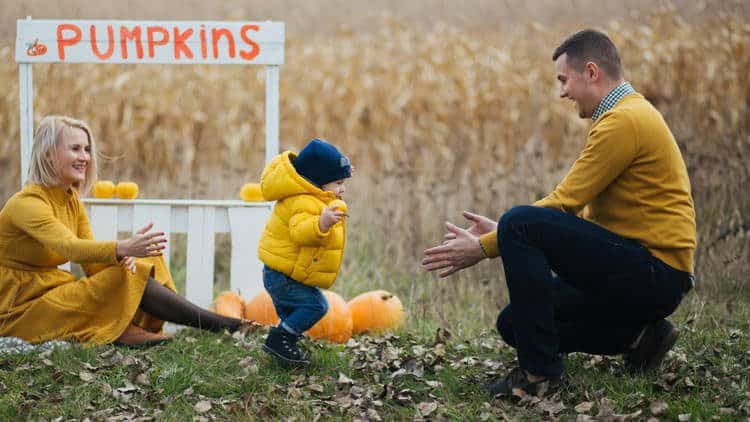You are your child’s favorite toy. There is nothing in the world your child would rather do than play with you!
Use the ideas below as a starting point for the many joyful ways there are to explore, play, learn, and discover with your child.
January
January’s theme is Cold. Try these fun activities to explore winter weather:
Talk Together
- For your baby: Use the word “cold” when the two of you touch cold water, snow, or ice, open the fridge, or when you go outside in cold weather. Babies learn to speak when others speak to them. Repetition helps, as does changing your tone of voice for the word you are emphasizing (i.e., using a higher tone): “Feel the cold water. Ooooh, that’s cold, isn’t it? Cold, cold water.” Listen for your baby’s response. Starting at about 1 year, you may hear your baby start to imitate your sounds: “Co co.”
- For your toddler: Talk about what “cold” feels like. Use other words for “cold”—like “freezing,” “icy,” or “chilly.” You can start to discuss seasons, how in winter we have cold weather, like snow and ice.
Read Together
- Try some “freezing” winter books like The Snowy Day by Ezra Jack Keats or Snowballs by Lois Ehlert.
Play Together
- For your baby: For your baby: Let your baby (6 months and up) do ice play. Put a few wet ice cubes on her high chair try to touch and play with. How does she respond to this cold, wet stuff?
- For your toddler: Talk about how water turns into ice when it freezes. Then play “freeze” with your toddler. When you say “freeze,” everyone has to stops moving. When you say “go,” everyone can start moving again. Try letting your toddler have a turn calling “freeze” and “go.” You can start/stop music to enhance this game as well. Let your toddler (18 mos. and up) experiment with ice. Shave some ice in a blender. Put it in a shallow pan, along with some ice cubes for fun, but cold, play. Throw in some spoons, cups, and bowls for him to scoop and dump with. For clean-up, let your child help you melt the ice with warm water and pour it down the drain. Talk about how the warm water melts the ice and turns it back into water.
February
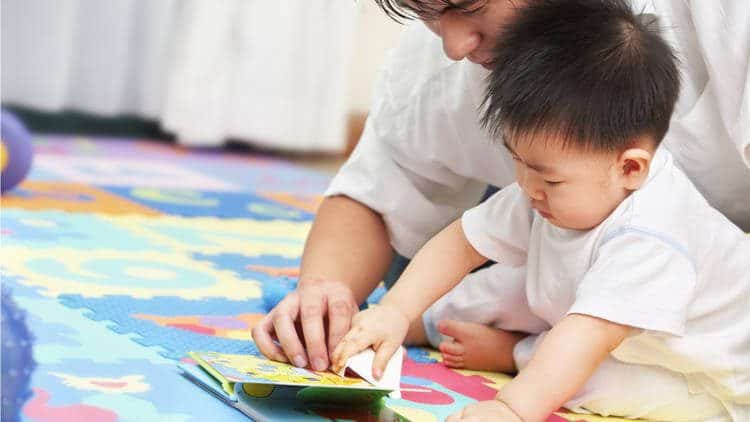
February’s theme is Textures. Try these fun activities to explore new textures:
Talk Together
- For your baby: Pick one or two concepts (perhaps soft/hard and bumpy/smooth) and use these words as your talk with your baby across the day. “What a soft blanket you have!” “That rattle feels bumpy, doesn’t it?” Follow your baby’s lead and let her linger over textures she seems to find interesting (“yes, your blanket has a smooth edge, and a soft middle”). There may also be textures she does not enjoy, and that’s okay, too. You can label her feelings (“I bet that oatmeal feels sticky on your hands”) and give her something else to touch.
- For your toddler: Discover textures with your toddler and talk about how they feel (soft/hard, bumpy/smooth, silky/rubbery, etc.). Be creative about where you find textures: The leaves of a plant can feel “pointy” or the lint you clean from the dryer can feel “woolly.” As your toddler grows and develops more language, you can ask him “What does this feel like to you?”
Read Together
- Try reading some touch-and-feel books together. For babies, Animal Kisses by Barney Saltzburg is always a favorite, as is the classic Pat the Bunny by Dorothy Kunhardt. Older toddlers may also enjoy I Am Happy: A Touch and Feel Book of Feelings by Steve Light which links feelings and textures. The touch-and-feel books from the Spot series by Eric Hill are usually a big hit, too.
Play Together
- For your baby: Let your baby touch and play with a set of differently textured fabrics. Offer her silky scarves, textured lace pieces, a soft cotton handkerchief. Play peek-a-boo behind the different fabrics. See if she tries to pull the scarf off your head! Which textures does your baby seem to like best?
- For your toddler: Make texture Valentines. Cut squares from different papers and materials—cloth, lace, ribbon, sandpaper, aluminum, foil, etc. Pour some glue (another texture to touch!) into a plastic bowl and let your child pick a square, dip it in the glue, and then glue it to a sturdy piece of paper you have cut into a heart shape. Follow your child’s lead; if she is done after gluing 2 squares or if she only wants to glue the foil on, that’s okay. When you’re done, hang her “masterpiece” at her eye-level so she can show everyone her work.
- For babies and toddlers: Make a texture book for your child. In honor of Valentine’s Day, cut heart shapes from a variety of differently textured fabrics and papers—lace, satin, cotton, corduroy, sandpaper, corrugated cardboard, etc. You can glue these into a book and write the texture on each page (“silky,” “scratchy,” etc.)
March

March’s theme is Rain. Try these fun activities to explore weather, both inside and outside:
Talk Together
- For your baby: Sing songs like Rain, Rain Go Away and Itsy Bitsy Spider with your baby. Try using hand gesture while you sing Itsy Bitsy Spider—your baby loves to watch you entertain her! Watch your baby—after she sees you do the gestures several times, she may try to copy you!
- For your toddler: Sing songs like Rain, Rain Go Away and Itsy Bitsy Spider together. Teach your child the gestures that go with Itsy Bitsy Spider. Talk about different rain words: puddles, rain boots and raincoats, umbrellas, pouring, sprinkling, misting, fog, wind, and clouds. Look outside: How many of these words do you see outside your window?
Read Together
- Read some rainy day books together. For babies, try Rain Feet by Angela Johnson or Gossie and Gertie by Olivia Dunrea, featuring Gossie the duck who loves her red galoshes. For older toddlers, good choices include The Little Cloud by Eric Carle, Rain or Shine: All About Weather by Danielle Denega and the ultimate rainy day fantasy, The Cat in the Hat by Dr. Seuss.
Play Together
- For your baby: Play with “rain” inside. In the bathtub, you can pour water out of a plastic pitcher to make rain. Does your baby prefer the water to come out slowly or quickly? Does she try to grab the stream of water? Try pouring water through a strainer and watch it sprinkle out. You can also pour water onto a plastic plate and let it splash every which way. Blow bubbles while your child is in the bathtub and sing Rain, Rain Go Away as the bubble “raindrops” float over her head.
- For your toddler: Make a weather chart. Every morning look outside the window with your toddler: “What do you see? Is it rainy, cloudy, or sunny?” Draw a sun, clouds, or raindrops on a piece of paper with the appropriate word underneath. Let your toddler help by coloring and drawing with you. Post each day’s forecast and talk about the week’s weather on Friday. Can your child remember the words for each type of weather? A variation on this activity is to let your older toddler draw the weather him/herself. You could also trace symbols of each kind of weather—a sun, an umbrella, a cloud—onto paper and let your older toddler cut out the shape and then glue it to her weather chart.
- For older toddlers: Go for a rain walk. Bundle up in raincoat and rainboots; put a rain shield over the stroller. Open the umbrellas. Go out in the rain (but not when it’s thunder-and-lightning out). What do you see? Raindrops on leaves? Worms? Puddles? Don’t worry if your toddler gets wet while he’s exploring; have some dry clothes and a towel right inside the door so he can warm up and talk all about what you’ve just seen.
April

April’s theme is Colors. Try these fun activities to learn colors and to try some new artistic activities:
Talk Together
- For your baby: Notice the colors that fill your baby’s world. Point out his red hat, the green leaves, the orange tabby cat. Have a snack of yellow bananas, red strawberries, and purple grapes. Look out into the black night and try to find yellow stars winking in the sky.
- For your toddler: Once your child knows the names of colors, you can begin to use these words in context: “Can you get your red sneakers?” “Would you like a green apple or a yellow apple for snack?” You can also begin to expand your child’s understanding of color by pointing out the difference between grass green and lime green, lemon yellow and golden yellow. April is the time when color begins to bloom outside with flowers and trees. What colors can your child find in the world around her?
Read Together
- Read some colorful books. For babies, try Spot Looks at Colors by Eric Hill, the Colors board book by DK Publishing, My Very First Book of Colors by Eric Carle, or Color Zoo by Lois Ehlert. For older toddlers, good choices include Brown Bear, Brown Bear, What Do You See by Bill Martin, Jr., Frederick by Leo Lionni, What Makes a Rainbow by Betty Ann Schwartz, Planting a Rainbow by Lois Ehlert, and My Many Colored Days by Dr. Seuss.
Play Together
- For your baby: Make color trays. Take a muffin tray and in each opening place an object that is red, for example. You could place a strawberry, a red teether, a piece of red watermelon, a red mitten or sock, and a red foam ball (make sure it is not a choking hazard). Let your baby touch and play with these objects, but supervise closely since babies this age are likely to “mouth” things they find interesting in order to learn more about them. As you baby plays, you can repeat the word “red”—a red ball, a red strawberry, a red sock. Try making trays of different colored objects.
- For your toddler: Toddlers love to help out doing “real” jobs around the house. For colors, try a cooking project where make a rainbow snack together. Pick out a range of healthy foods of different colors—yellow bananas, red watermelon, green grapes, blueberries, etc. Let your child choose what to have as his snack and talk about all the different colors he can eat. What does he think is the best-tasting color?
- For babies and toddlers: Make a color book. Staple together 6 pages of construction paper (red, orange, yellow, green, blue, and purple) to make a book. Write the appropriate color’s name on each page. Let your child color pictures on each page. Cut photos from magazines and have your child glue these pictures on the right color page (e.g., a photo of a red apple goes on the red page). Read your book together—what is her favorite page? An alternative is to take six photos of your child wearing a shirt of each color and gluing them to the appropriate pages.
May
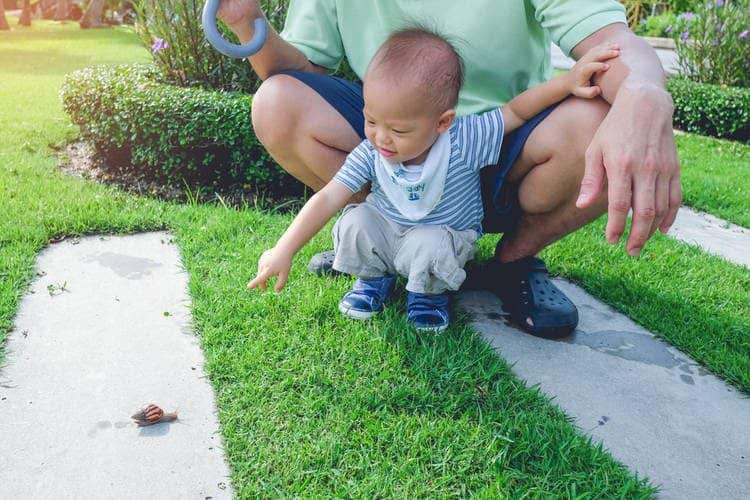
May’s theme is Animals. Try these fun activities to learn about animals and play pretend:
Talk Together
- For your baby: What animals do you see outside? Name these different creatures for your baby: birds, squirrels, ducks, dogs, cats, rabbits. Which animal does your baby seem most interested in? Make each animal’s sounds. Which sound makes your baby giggle?
- For your toddler: Baby animals are a special part of spring—can you spot any in your neighborhood? Go on a “safari walk” with your toddler and ask her to tell you when she sees an animal. Does she know the animal’s name? The sound it makes? Does she know where it lives (nest, pond, trees, etc.)? Watch these animals with your child and talk about what you see.
Read Together
- Read books that feature different kinds of animals. For babies, try: Whose Nose and Toes? by John Butler, Does a Kangaroo Have a Mother, Too? by Eric Carle, Good Night, Gorilla by Peggy Rathmann, Baby Animals by DK Publishing, and Country Animals, Farm Animals, and Pet Animals by Lucy Cousins. For older toddlers, good choices include Over in the Meadow by Ezra Jack Keats, Make Way for Ducklings by Robert McCloskey, Mrs. Brown Went to Town by Wong Herbert Yee, Cock-a-Doodle-Doo! Barnyard Hullabaloo by Giles Andreae, The Napping House by Audrey Wood, and I Love My Mama by Peter Kavanagh.
Play Together
- For your baby: Babies are often captivated by watching animals outside or through the window. Stick with your baby and let him watch as long as he wants, though be very cautious about approaching animals you do not know. Teaching your child animal safety begins early. You can support your baby’s interest in animals by, for example, installing a bird feeder to encourage birds to visit. For an indoor activity, you can give your baby swatches of fake fur and feathers to touch (both available at craft stores).
- For your toddler: Cut pictures of animals out of magazines and glue them to sturdy cardboard. Make sure there are matches—2 pictures of horses, 2 pictures of sheep, etc. Lay these pictures out (face up) on the floor and see if your child can match the animals that are the same. Matching games build thinking skills in your toddler. You can also play “barnyard.” With your child, walk and “talk” like an animal—perhaps meow like a cat or “trot” and neigh like horse. Which animals does your child like to be? Turn a big cardboard box into a barn and see if your child would like to pretend to trot in and out.
June
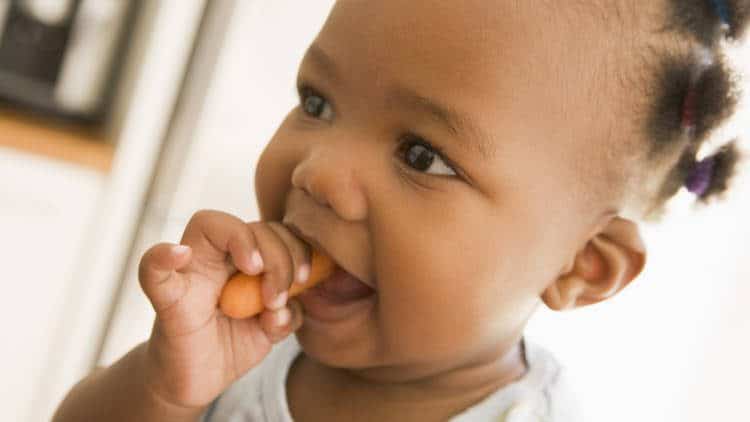
June’s theme is Fruits and Vegetables. Try these fun activities to learn more about healthy foods:
Talk Together
- For your baby: Name the foods that your baby eats. During meals, ask your baby “Would you like some banana? How about more carrots?” Though she doesn’t understand you yet, by talking about these objects over and over you are helping your baby understand that a word (“strawberry”) stands for a thing (a sweet red fruit). When you are at the supermarket, you can also point out the fruits and vegetables that your baby likes to eat. Soon, your baby may be pointing out the ones she recognizes all by herself!
- For your toddler: June is when gardens begin growing and when early crops (like strawberries) are ready. During meals, talk about the different fruits and vegetables your child is eating. Ask her which she likes best. Talk about their colors and textures. When you are at the supermarket, talk about and show your baby the variety of fruits and vegetables in the produce section. Let her touch the spiny pineapple, the fuzzy kiwi, the smooth pepper, the bumpy broccoli. Let your toddler pick one new fruit or vegetable to take home and try to eat. Does she like this new taste or not?
Read Together
- Read books about fruits and vegetables and all the yummy things we can make with them. For babies, try: The Little Mouse, the Red Ripe Strawberry, and the Big Hungry Bear by Don Wood, Planting a Rainbow, Eating the Alphabet, and Growing Vegetable Soup, all by Lois Ehlert, and The Very Hungry Caterpillar by Eric Carle. For older toddlers, good choices include Jamberry by Bruce Degan, Blueberries for Sal by Robert McCloskey, How Are You Peeling? by Joost Elffers, and Lunch by Denise Fleming.
Play Together
- For your baby: For babies on solid foods, you can slice into bite-sized pieces several different fruits and vegetables (ask your health care provider before introducing new foods). Let your baby play with the food, touch it, and lick it. Maybe he will even taste it. Which ones does he like the best? You can also let your baby touch different fruits and vegetables so he can experience their very different textures and colors. Which ones does he like to touch? Which ones doesn’t he like?
- For your toddler: Plant some seeds (carrot or bean seeds often work best) in a square of dirt outside or in a pot to keep inside. This is a fun project for toddlers who love to shovel dirt, pour water, and get messy! Watch your seed grow over the next few weeks (remember to water every few days). Have a garden snack when your plant has grown big enough to “harvest”! You can also have a “taste test” with your toddler as your lay slices of various fruits and/or vegetables out on a plate. Let your child decide which to try, which to touch, and which to avoid. Talk about how each one looks and tastes. What fruits and vegetables are your child’s favorites? Try doing a cooking project with your toddler by squeezing your own orange juice, making fruit salad (put your toddler in charge of dropping blueberries or pre-sliced fruit into the bowl) or by making a special summer drink together (blend vanilla yogurt with fruits like strawberries, blueberries, and/or bananas).
July

July’s theme is Body Parts. Try these fun activities to help your child learn more about their body:
Talk Together
- For your baby: During your baby’s bath, you can sing Head and shoulders, knees and toes, knees and toes, knees and toes, head and shoulders, knees and toes. This is baby’s body! Eyes and mouth and ears and nose, ears and nose, ears and nose. Eyes and mouth and ears and nose. This is baby’s body! As you sing, be sure to gently touch each body part.
- For your toddler: Ask your toddler Where’s your…NOSE? After he shows you, ask Where’s your…KNEE? Continue the game, giving him a kiss on each body part. With toddlers who are potty training, it is especially important to give them words to talk about their private parts. This helps children understand what is happening during potty training and to communicate more clearly with you when they feel a need to use the potty.
Read Together
- Read books about all of our different body parts. For babies, try: Where is Baby’s Belly Button? and Toes, Ears, and Nose!, both by Karen Katz, and Ten Little Fingers and Head, Shoulders, Knees, and Toes, both by Annie Kubler. For older toddlers, good choices include My First Body Board Book by DK Publishing, Horns to Toes and In Between by Sandra Boynton, From Head to Toe by Eric Carle, and Clarabella’s Teeth by An Vrombaut.
Play Together
- For your baby: Try some infant massage techniques on your baby. Wait until your baby is relaxed, fed, and in a good mood. Then give it a try. Ask your baby is you can touch her, and then gently rub and massage her legs, arms, feet, and hands. (Use lotion or a physician-okayed body oil, if you’d like.) If your baby gets distressed or doesn’t like to be touched this way, stop and try again another time. As you touch your baby, talk about her different body parts. Activities like this help your baby know where her body begins and ends (a concept called “body awareness”).
- For your toddler: Toddlers love challenges, especially as they are growing stronger and more coordinated physically. Ask your child “Can you lift your leg? Can you touch your hands to your knees?” Using the names of her body parts in context helps her learn, and also gives her a chance to show you all that she can do with her growing body. You can play a similar game outside by turning a sprinkler on (keep the spray low so that it is about the same height as your child). Then ask your toddler, Can you put your foot in the water? Can you put your hand in the water? Can you jump your whole body through the water? Make the most of July’s warm weather by doing footstep paintings outside. Pour washable tempera paint into a shallow metal dish. Lay a piece of paper in front of the dish and then another shallow pan of water on the other side of the paper. Have your child step (barefoot) into the paint, then walk all around the paper, then step into the dish of water to wash off. Have a towel handy to dry her toes. Another (less messy) idea is to trace your child’s hand or feet onto a piece of paper. Let your child color in or decorate the tracing. Then trace your hand or foot. Whose is bigger or smaller? If you can find a roll of butcher paper (available at craft stores), you can even try tracing your child’s entire body. You can talk about, draw, and color all your child’s different body parts.
August
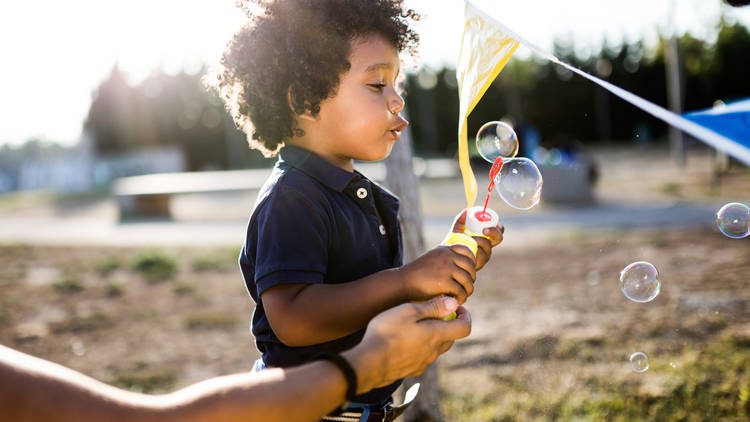
The theme for August is Bubbles. Try these fun activities to help your child learn more about bubbles, sounds, and cleaning:
Talk Together
- For your baby: As you and your baby play with bubbles, focus on repeating the words “bubble” and “pop.” Point at the bubbles floating away: “Look at the bubbles go!” Cue your baby to “Pop the bubbles.” See if your baby tries to imitate you. Listen for “buh” or “pa” sounds.
- For your toddler: Talk to your toddler about the “ingredients” for making bubbles. First you open the soap suds and dip the bubble wand inside. Then you gently blow and then the bubbles fly away. You can do all sorts of things with bubbles: catch them, pop them with your finger, clap them between your hands, pile them up on your palm. You’ll be amazed at all the different words you can use to talk about bubbles!
Read Together
- Read books that include some bubbles in the story. For babies, try: Clifford Counts Bubbles by Norman Bridwell, Squeaky Clean by Simon Puttock, and Jesse Bear, What Will You Wear? by Nancy White Carlstrom. For older toddlers, good choices include Bubble Bubble by Mercer Mayer, Bubbles Bubbles by Kathi Appelt, and The Scrubbly-Bubbly Car Wash by Irene O’Garden.
Play Together
- For your baby: Sit outside with your baby and start blowing bubbles. What does your baby do? Does he reach out to touch them? Follow them with his eyes? Catch a bubble on the bubble wand. Ask him if he wants to pop it and then let him “grab” it with his fingers. Let your baby play with oodles of bubbles. Seat him in his high chair. Meanwhile, squirt some dish detergent in the bowl and then run water into the bowl, making lots of bubbles. Scoop a handful of bubbles out and put them on your baby’s high chair tray. Watch him touch and explore these funny bubbles. Just be careful he doesn’t eat them!
- For your toddler: Play “Pop the Bubble” outside. Tell your child that her job will be to try and “catch” as many bubbles as she can and pop them. Start blowing bubbles and watch her dash to catch them. As you play, you can sing (to the tune of Pop Goes the Weasel): Round and round the grassy yard my baby chases bubbles, Pop goes the bubbles! Make bubble art. Mix about a cup of bubble solution with about 1–2 tablespoons of washable tempera paint. Hang a piece of paper outside (use binder clips to hang on a fence) and have your child blow bubbles at the paper. An alternative is for a grown-up to put a plastic straw into the bubble-paint solution and blow, forming lots of bubbles (careful, don’t swallow). Children can then press the paper into the bubbles that are overflowing out of the bowl.
September
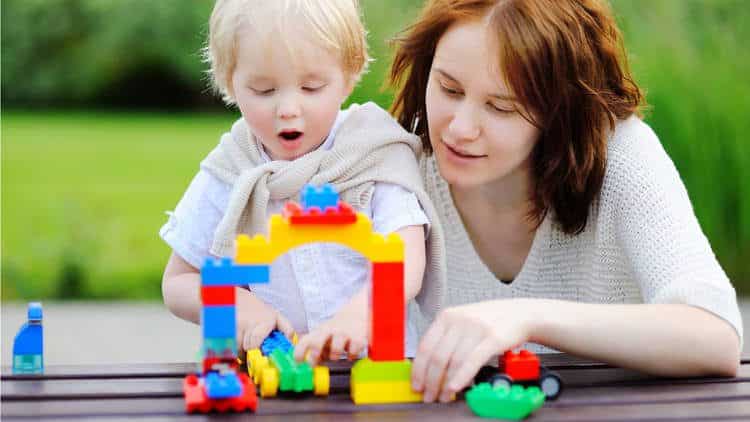
September’s theme is Cars, Trucks, and Buses. Try these fun activities to help your child learn more about cars, motion, and the world around them:
Talk Together
- For your baby: Take a walk see how many vehicles you can spot. Point them out and repeat their names: Truck! Bus! Car! Start to help your child make sentences as you watch the traffic zooming by: Cars go. Trucks go. The bus stops. Now it goes. Watch and listen for your baby’s attempt to tell you when he spots a four-wheeled wonder. Listen for ka, tuck, and ba sounds. Watch for your baby to point and gesture at a bright yellow bus.
- For your toddler: This is an exciting time of year with school buses taking to the streets once again. Watch the traffic go by with your child. Use descriptor words to expand his vocabulary; notice the red car, the garbage truck, the yellow school bus. Use the actual terms for vehicles like bulldozers, front-end loaders, and cranes. Talk about how the school bus and the city bus are different. Read the stop signs with your child. Which cars does your child like best?
Read Together
- Read books with wheels! For babies, try: My Car and Machines at Work by Byron Barton, My First Truck Board Book by DK Publishing, Wheels on the Bus by Annie Kubler, Truck Duck by Michael Rex, and Richard Scarry’s Cars and Trucks from A to Z. For older toddlers, good choices include Cars, Trucks and Things That Go by Richard Scarry, Miss Spider’s New Car by David Kirk, Mike Mulligan and His Steam Shovel by Virginia Lee Burton, Don’t Let the Pigeon Drive the Bus by Mo Willems, and My Race Car and My Fire Engine by Michael Rex.
Play Together
- For your baby: Seat your baby in her high chair. Pour a little washable paint onto a paper plate. Tape a piece of paper to your baby’s high chair tray. Dip the wheels of a die-cast car into the paint and let your baby “drive” it over the paper. Voila! Car art! Have a “car conversation” with your baby. Seat your baby on the floor and sit across from her. Roll a toy car to her and encourage herm to roll it back. See if you can get this back-and-forth game going. Turn-taking activities like this one are practice for both “real” conversations later on, as well as sharing skills that will be developing over the next few years.
- For your toddler: Play stop and go. Color one side of a paper plate red and write the word “stop” on it. Color the other side green and write the word “go.” If you’d like, glue a popsicle stick to the bottom so you can easily hold it. Let you child pretend to be a car (encourage him to make brum brum honk honk noises). You will be the traffic light. The “car” has to stop at the red sign and can go at the green sign. Once your child has the hang of this game, see if he’d like to tell you when to stop and go. Have a car wash. Let your child pick out a few of his toy cars or a bicycle to wash. Fill a bucket with soapy water and give you child an assortment of rags and sponges. Watch him get everything squeaky clean. Have a towel nearby to make drying off easy when he is all done.
October
October’s theme is Pumpkins. Try these fun activities to help your child learn more about fall and cooking:
Talk Together
- For your baby: Look at pumpkins in the pumpkin patch or at your local supermarket. Let your baby touch the pumpkins. Talk about how they look and feel—they’re big, and round, and orange. Are they smooth or bumpy? Knock on the pumpkin. Is your baby interested in this sound? Let her try to knock on the pumpkin, too.
- For your toddler: Look at pumpkins in the pumpkin patch or at your local supermarket. Talk about the pumpkins with your toddler—their color, texture, shape, and size. Use new words to describe the pumpkins; this helps expand your child’s vocabulary. For example, you can talk about the scratchy stalk or the tough vine. You can talk about where pumpkins grow—in a pumpkin patch. You can talk about how pumpkins grow—from seeds (think about buying a packet of pumpkin seeds to show your child). Which of the pumpkins is your child’s favorite? Why?
Read Together
- Read stories about this most special part of fall—round, orange pumpkins! For babies, try: Plumply Dumply Pumpkin by Mary Serfozo, The Little Pumpkin Book by Katy Bratun, and My Jack-O-Lantern by Nancy J. Skarmeas. For older toddlers, good choices include. Apples and Pumpkins by Anne Rockwell, It’s Pumpkin Time by Zoe Hall, Pumpkin Pumpkin by Jeanne Titherington, and Too Many Pumpkins by Linda White.
Play Together
- For your baby: Purchase a tiny pumpkin (or gourd) and let your baby finger-paint it using washable tempera paints. Give your baby a taste of pumpkin pie filling (look for a low/no sugar brand) or a pumpkin muffin. (But first talk to your pediatrician before introducing any new fruits and vegetables into your baby’s diet.) What does your baby think of this new taste?
- For your toddler: Line a table with newspaper or a plastic tablecloth. Cut the top off a pumpkin (adults only) so that your child can help you reach inside with a big spoon and take out all the seeds. Let your child play with the seeds and “pumpkin innards.” This kind of sensory play is great fun for toddlers who love to get messy. Be aware, though, that some children won’t like the feeling of the smushy pumpkin and will want to get washed up right away. When you are done emptying the pumpkin, your child can paint it using washable tempera paints or draw on it using washable markers.
Do a cooking project with your toddler. Try making the easy pumpkin muffin recipe below. Involve your child in scooping, stirring, and dumping ingredients in. Be sure to keep him away, though, when it’s time to use the oven and let those hot muffins cool down before you dig in!
- Pumpkin Muffins
- 1/3 cup sugar
- 1/3 cup oil
- 3 eggs
- 15-oz. can of pumpkin pie filling
- 3 teaspoon pumpkin pie spice (or substitute 1 tsp cinnamon, 1 tsp nutmeg, and 1 tsp cloves)
- 1 box yellow cake mix
- 1 bag mini chocolate chips (optional)
- Blend the sugar, oil, eggs, and pumpkin together for 1 minute on high. (adults only)
- Add the pumpkin pie spice and cake mix. Beat for 2 minutes on high. (adults only)
- Mix the chocolate chips in by hand (if using).
- Pour the batter into muffin papers placed in a muffin pan. Bake as the cake mix box directs. Stick a toothpick in (should come out clean) to check for doneness. Makes about 1½ dozen muffins.
November

November’s theme is Trees. Try these fun activities to help your child learn more about nature and fall:
Talk Together
- For your baby: Lay a cozy blanket down on the grass and lie underneath a tree with your baby. Talk about the tree, the branches, the leaves and the wind. Repeat the word tree and let your baby touch the tree’s trunk and leaves.
- For your toddler: Take a walk with your toddler to see how many different trees and leaves you can find. Talk about how a maple tree leaves feel different than a pine tree’s needles. Feel the tree’s bark; how does your child think the bark feels? Is it rough or bumpy, smooth or sticky with sap? Look at the leaves on the ground. Collect some of your child’s favorites and line them up on the ground. Name their colors. Then line them up by size, from big leaves to little leaves. Pick some leaves to bring home.
Read Together
- Read books all about trees and their leaves. For babies, try: Chicka Chicka Boom Boom by Bill Martin, Jr., Five Little Monkeys Sitting in a Tree by Eileen Christelow, and Leaf Baby by Mary Brigid Barrett. For older toddlers, good choices include: Caps for Sale by Esphyr Slobodkina, Go Dog Go by P. D. Eastman, and The Acorn and the Oak Tree by Lori Froeb.
Play Together
- For your baby: Collect a few leaves, some crinkly, some not. Give them to your baby to play with and explore with his hands. Crinkle one so he can listen to the sound the leaf makes. Which leaves does he seem to like best? What does he like to do with the leaves? Play leaf peek-a-boo. Find a big leaf that you can use to cover (most) of your face. Hold it front of you and then pull it away: Peek-a-boo! See if your baby wants to take the leaf and play peek-a-boo with you.
- For your toddler: Choose a few different leaves for your child to paint with. Squirt washable tempera paint onto a paper plate. Show your child how to dip the leaves into the paint and then “stamp” onto paper. Make “secret boxes” for your child to explore. Take three shoeboxes and cut a hand-sized hole in the side of each. Put a different interesting item inside each box (a few acorns, some crinkly leaves, a stick). Have your child put her hand inside and touch the object without looking. Can she guess what is inside? (Note: Some children may be reluctant to put their hand inside the box without knowing what is inside. That’s okay—modify the activity by having your child help you put the items inside each box. This might help her feel more comfortable with touching without seeing.)
December

December’s theme is Stars. Try these fun activities to help your child learn more about space and nighttime:
Talk Together
- For your baby: Sing Twinkle Twinkle Little Star with your baby, using hand gestures to go along with the song. Bundle your baby up one evening before bed and show her the stars. Point them out, repeating the word star. Listen for her to try saying it—it might sound like tar, sa or sar.
- For your toddler: Sing Twinkle Twinkle Little Star and teach your toddler hand gestures to go with the song (flick your fingers for twinkling stars, wave your hands over your head for up above the world so high, etc.). Take your child outside before bedtime and look up into the night-time sky. Can he find any stars? What color are they? Are they bright? Are they twinkling? What else does he see in the night sky—a moon, an owl, a plane?
Read Together
- Read some starry books together. For babies, try: Sleep Songs: Twinkle, Twinkle Little Star/Golden Slumbers by Amanda Wallwork, Little Bear’s Special Wish by Gillian Lobel, and the classic Goodnight Moon by Margaret Wise Brown. For older toddlers, good choices include. Hush Little Baby and Twinkle Twinkle Little Star, both by Sylvia Long, Owl Moon by Jane Yolen, and Forest Bright, Forest Night by Jennifer Ward.
Play Together
- For your baby: Play “basketstar” with your baby. Buy a few star-shaped cookie cutters in different shapes or cut star shapes out of cardboard. Let your baby touch these and play with them. If you hold out a metal bowl, see if your baby will drop the cookie cutters in (they will make an exciting clatter). When she’s done, you can take them out and play “basketstar” all over again.
- For your toddler: Cut a large star out of heavy cardboard. Let your child paint or color the star any color he’d like. Decorating it with glitter is always fun, too! You can make a small hole at the top of the star, thread a short piece of string through, and hang in front of a window (adults only). Older toddlers can use the cardboard star as a model to trace onto a piece of paper and continue the activity as outlined above. Try making a starry night sky. Cut a few star shapes from a new kitchen sponge. Then give your child a piece of black or blue paper and pour a little washable yellow tempera paint into a bowl. Show your child how to dip the sponge star into the paint and then onto the “sky” paper. See how starry your child’s sky is. Make a starry snack. Using a star-shaped cookie cutter, let your child press stars out of cheese slices and pieces of bread. Ask your toddler: “What do stars taste like?”



